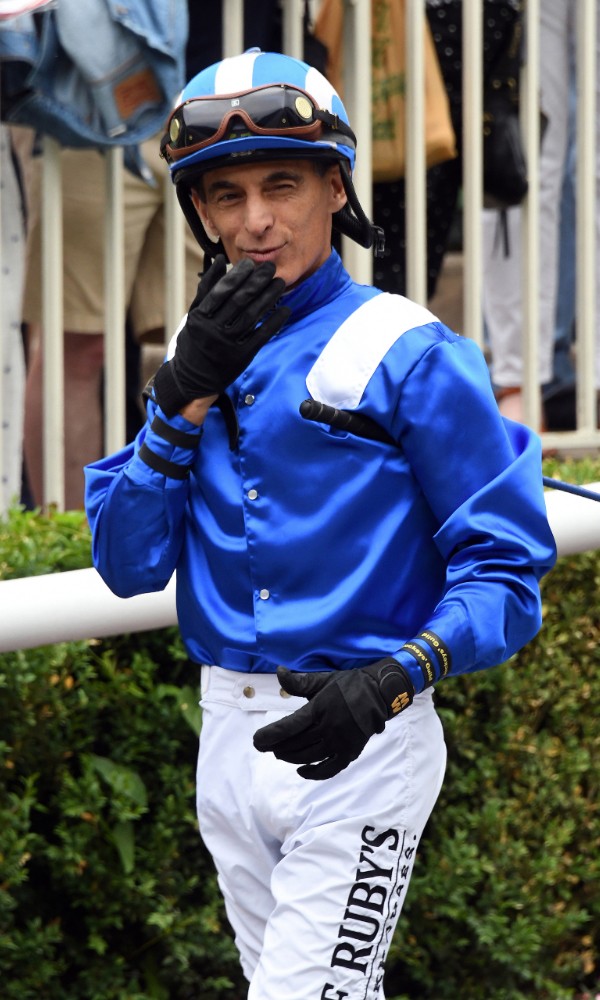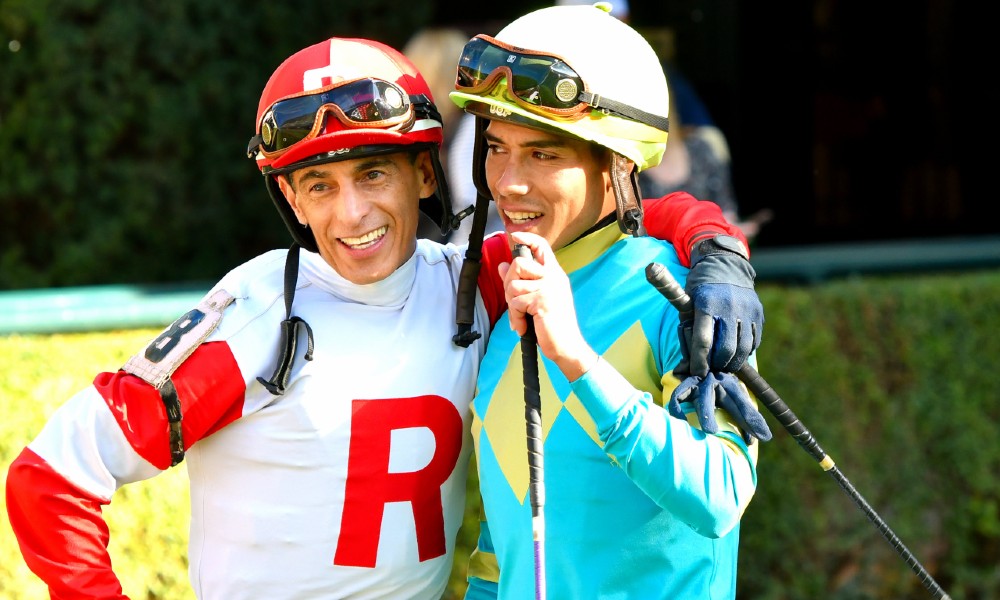John Velazquez warmheartedly remembers his humble beginnings learning to ride horses while growing up in Puerto Rico. He never envisioned those early learn-on-the-fly experiences competing in unsanctioned street races—relying on instincts and natural ability instead of formal schooling—would set him on a path to become one of the most accomplished and revered jockeys of all time.
“It’s pretty wild to think back to those days,” Velazquez says. “I just got on horses as a young kid, without any real teaching at first, and would race through the streets. It was kind of crazy. I caught the bug for it right away. It didn’t matter what surface you were on or what horse you were on. I’d ride any horse that was available for a couple hundred yards or so and just go for it. I didn’t know a lot, but I was eager to learn. I just wanted to ride and be able to win and have those bragging rights.”
Velazquez eventually received conventional riding instruction at Escuela Vocacional Hipica, the state-run jockey academy at Puerto Rico’s Camarero Race Track, which he entered in 1988 at the age of 16. He wasn’t as experienced as some of his peers or as advanced in the technical aspects of riding, but his natural horsemanship and aptitude in the irons more than overcame any early deficiencies in his technique. The education Velazquez received in both the streets and at the jockey school convinced him that riding racehorses was his calling. He ventured to America early in 1990 and the results unquestionably validated the decision.
Through mid-June, Velazquez has won more than 6,400 races. His staggering purse earnings of $452.4 million rank him No. 1 of all time, $83 million more than No. 2 Javier Castellano. Velazquez has done it all. Inducted into the Hall of Fame in 2012, he has won both the Kentucky Derby and Belmont Stakes three times each, earned a pair of Eclipse Awards, and thrived at the Breeders’ Cup with 18 victories. He’s won 22 individual meet riding titles in New York, including five at Saratoga, where he became the Spa’s all-time wins leader in 2013. Velazquez comes into the 2022 Saratoga meeting needing only 17 wins to become the first jockey to reach 1,000 at Saratoga. His Saratoga earnings of $77.9 million is also a record.

“I’ve worked very hard, always tried to learn and improve, and I’m proud of what I’ve been able to accomplish,” says the 50-year-old. “I also realize I’ve been incredibly fortunate. You can’t do any of it on your own. I’ve been lucky to have had great trainers and owners support and believe in me, and I’ve had the horses. You’re not going to do much in this sport unless you get the opportunity to ride the good ones. It all comes down to the horse, and those really good ones will motivate you to be your best.”
Talent and work ethic have afforded Velazquez the opportunity to ride Hall of Fame members Ashado and Wise Dan, as well as champions such as Animal Kingdom, Authentic, English Channel, Gamine, Malathaat, Rags to Riches, Sistercharlie and Uncle Mo, among others. He’s come a long way from his days as a teenager sending tapes of his early wins to trainers in New York in hopes of getting their attention. Velazquez got a big break when he met fellow Puerto Rico native Angel Cordero, Jr. in 1990. Cordero, who was inducted into the Hall of Fame in 1988, was still riding when he took the teenage Velazquez under his wing and into his house. Velazquez began to learn English by watching The Little Mermaid with Cordero’s daughter, Canela. An injury forced Cordero to retire in 1992 and he later served as the agent for the emerging Velazquez.
Competing on the challenging New York circuit, Velazquez slowly worked his way into the upper echelon of the elite jockey colony. But success didn’t come overnight for the rider known around the track simply as “Johnny V.” At Saratoga, for example, Velazquez struggled mightily early on. In 1990, his first year riding at the Spa, he won on only three of his 64 mounts. The following year, he was 8-for-95; in 1992 he was 2-for-85; and in 1993 he was 4-for-91. “I almost went back to Puerto Rico in 1992,” Velazquez says. “I wasn’t doing well at all and I had my doubts. I really had to keep pushing myself.” Eventually, that perseverance began to pay off. He won 11 races at Saratoga in 1994, then 25 in 1995, and was atop the standings at the Spa for the first time in 1998 with 31 wins. In 2004, the first of back-to-back years in which he won the Eclipse Award, Velazquez set a Saratoga single-meet record with 65 wins.
“Saratoga has been such a big part of my career and my life,” he says. “I did a lot of growing up here both on and off the track. There is absolutely no other place like it. It’s the biggest stage in racing. Of course the Triple Crown races are huge and so is the Breeders’ Cup, but Saratoga is a battle of the best, day in and day out, for 40 days. It’s the place [where] all the owners, trainers and jockeys want to be. Wins at Saratoga tend to mean a little bit more. It forces you to dig deeper if you want to be successful.”

Velazquez has been a credit to the sport in more ways than just his achievements in the saddle. He is universally respected by his peers and serves as a mentor to the younger riders. Velazquez has also served as chairman of the Jockeys’ Guild and as a board member for the Permanently Disabled Jockeys Fund. “I’ve always believed that I should give back and help others in the sport as best I can,” he says. “It’s a responsibility that I take very seriously. You want to see that next generation of riders have success and do things the right way, so I try to be a good example for them. That can be giving them tips on the track or advice about things like how to manage money or take care of their body or just in general about supporting the other riders in the jocks’ room.”
More than 30 years into his career, Velazquez is still challenging himself and trying new things. This past winter, he rode regularly at Santa Anita in California for the first time, instead of returning to his usual winter base at Gulfstream Park in Florida. Riding selectively, he piloted 32 winners there to finish fifth in the standings even though he had fewer mounts than all the riders ahead of him on the leaderboard.
“I wanted to try something I hadn’t previously done,” he says. “There were some stakes horses based out there I wanted to stay close to, and I’m at the point in my career that I can be flexible and experience different things. I really enjoyed it. Racing has taken me around the country and around the world and it’s been a life education.”
Although it is not unusual for jockeys to remain successful into their late 40s or early 50s, Velazquez admits his battle with Father Time to remain at the top of the game is a daily
test. “I’m not obsessed with working out,” he says. “I’m not big into running or lifting weights, so I focus on things like swimming, some yoga, stretching to stay flexible and loose. You have to put more into it physically as you get older, but I feel great. I’m definitely a smarter rider than I was in my 20s and 30s and my reflexes and instincts are as good as they’ve ever been. I feel I can compete with any of the younger guys out there because mentally it’s easier for me now. I’ve experienced pretty much every scenario you can think of on the track. I have plenty of motivation because I still enjoy what I’m doing so much and I don’t want to be out there unless I’m able to compete at the highest level.”
Velazquez says the support of his wife, Leona, and children, Lerina and Michael Patrick, has been vital to his continued success. And Leona, the daughter of trainer Leo O’Brien, could very well be his secret weapon.
“Leona was brought up in racing and she knew the sport better than I did,” Velazquez says. “Being a racing family is great in a lot of ways, but it also is very unique and it can be challenging. I never would have made it to this point if it didn’t work well for the family. Leona has really been amazing and she’s one of the biggest reasons I’ve done as well as I have.”
It’s been a decade since Velazquez was inducted into the Hall of Fame, yet he hasn’t shown any signs of decline, winning seven Breeders’ Cup races and two editions of the Kentucky Derby since his induction. Hall of Fame trainer Todd Pletcher, who began collaborating with Velazquez in 1998, said there is no better example of what defines a Hall of Famer than Velazquez. “There’s no magic number or certain amount of wins or money won or stakes wins or what have you that make someone eligible for the Hall of Fame, but whatever that magic number is, I think with Johnny’s induction today the bar has been raised at every level,” Pletcher said when introducing Velazquez at the 2012 induction ceremony. “He’s a terrific role model, a terrific husband, a caring father, and an all-around really super human being. No one deserves it more.”
Velazquez says he’s enjoying riding now as much as he ever has and has no intention of retiring anytime soon.
“I’m not riding for any reasons like checking certain wins or milestones off a bucket list or anything along those lines,” he says. “I think I’m enjoying it so much because I don’t feel there is any pressure on me at this point. As long as I’m healthy and capable of competing at the top level there is no thought of retirement. This is what I’m meant to be doing right now and I couldn’t be happier.”


